Perfume-making, a craft that marries artistry with scientific precision, traces its origins back over three millennia. At the forefront of this ancient craft was Tapputi-belat-ekalle, a remarkable figure regarded as the first chemist in history. Her practices, emerging from the Middle Assyrian period, unveil not only the richness of early perfume creation but also the sophistication of ancient societies in understanding and harnessing nature’s aromatic potential. Artifacts from this era, including clay tablets excavated from Mesopotamia, illustrate that Tapputi led a team of skilled female perfumers who concocted fragrances for royalty. This connection between gender, science, and beauty underscores the deep-rooted significance of perfumery in human culture.
From Ingredients to Art
To appreciate the artistry behind modern fragrances, we must journey back to the intricate methods employed by Tapputi and her contemporaries. The original recipes reveal a meticulous approach, showcasing a range of aromatic and medicinal components, adeptly extracted to form fragrant elixirs. The essence of perfume comes from its “notes,” which evoke emotions and memories alike. These notes, formed by volatile compounds, represent the heart of fragrance chemistry, characterized by their ability to evaporate and linger in the air, triggering sensory connections that are deeply personal.
As modern perfumers refine these ancient techniques, they reinvigorate the cultural heritage of their discipline. The processes of extraction, such as decoction, infusion, and maceration, are not just relics of a bygone era; they remain foundational in the creation of contemporary perfumes. The modern artisan’s toolkit, enhanced by technology, allows for greater precision in extracting and combining various scent notes, making the process both an art and a science.
The Chemistry of Emotion
Diving deeper into the aromatic world, one discovers the profound relationship between scent and emotion. Perfumes are not merely olfactory experiences; they are emotionally charged entities that can influence mood and behavior. The psychological dimension of fragrance is a burgeoning field that connects the dots between scents and the brain’s limbic system, which governs emotions and memory. This relationship explains why specific fragrances can trigger vivid memories or feelings—a phenomenon that resonates with historical uses of perfumes in religious rituals and ceremonies.
Tapputi’s creations were likely revered not just for their beauty but for their ability to engage the senses in spiritual contexts. Each scent was a bridge between worldly pleasures and divine connection. In today’s world, this aspect of perfumery is receiving renewed attention, as brands increasingly focus on storytelling and emotional resonance to engage consumers.
Innovations in Aromatic Science
As we navigate through the nexus of fragrance and scientific exploration, innovative technologies are redefining the industry. One such advancement lies in the development of electronic noses or “e-noses,” devices designed to replicate human olfactory capabilities. These high-tech tools promise to revolutionize quality control in food production and medical diagnostics by detecting changes in volatile compound signatures that could indicate spoilage or underlying health issues.
In the perfumery landscape, enhanced analytical techniques allow us to dissect complex aromas into their molecular components. This ongoing research reveals the sources of different scents, which could offer insights into the substances our ancient ancestors cherished, much like that of Tapputi’s famed recipes. The journey of understanding aroma is continually evolving, promising a fusion of historical reverence and cutting-edge technology.
Fragrance as an Experience
Fragrance creation today is not just about crafting pleasing scents; it is an immersive experience that considers context, mood, and environment. The modern perfumer acts as a storyteller, weaving together various scent elements to evoke specific feelings or thematic experiences. This holistic understanding reflects a significant evolution in the art of perfumery—moving from transactional interactions to deeply personal connections with consumers.
The inspiration for creating fragrances often ties back to nature and personal experiences, akin to the intimate relationship Tapputi had with her ingredients. Each scent crafted today has the potential to revive the long-lost narratives of ancient practices while appealing to contemporary sensibilities and desires.
The legacy of Tapputi is a testament to how fragrance formation transcends mere chemical reactions; it embodies cultural narratives and evokes emotional responses. As we continue exploring this fascinating intersection of art, science, and personal experience, it becomes clear that the world of fragrance is not only a celebration of past glories but also a continuous journey towards a fragrant future.


Leave a Reply